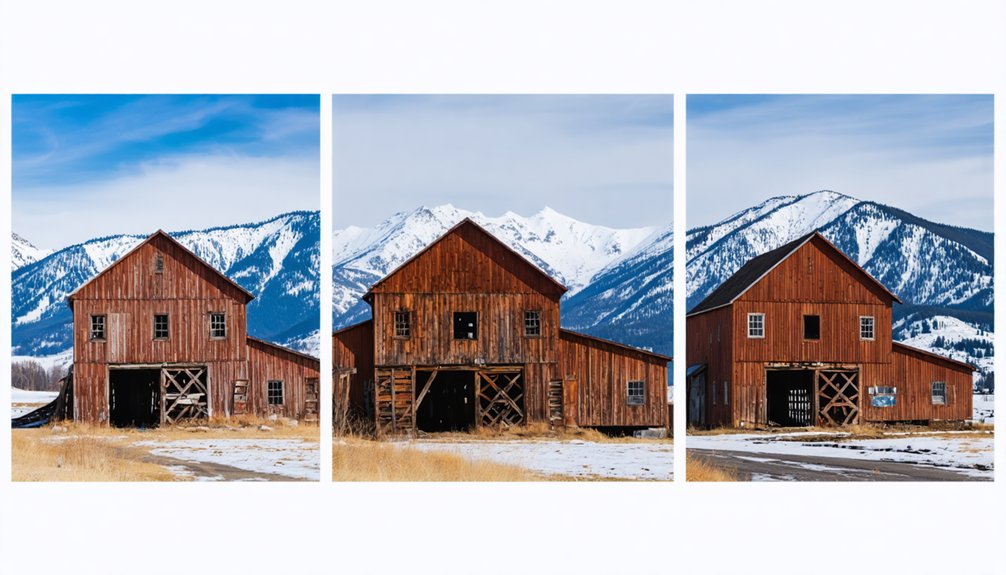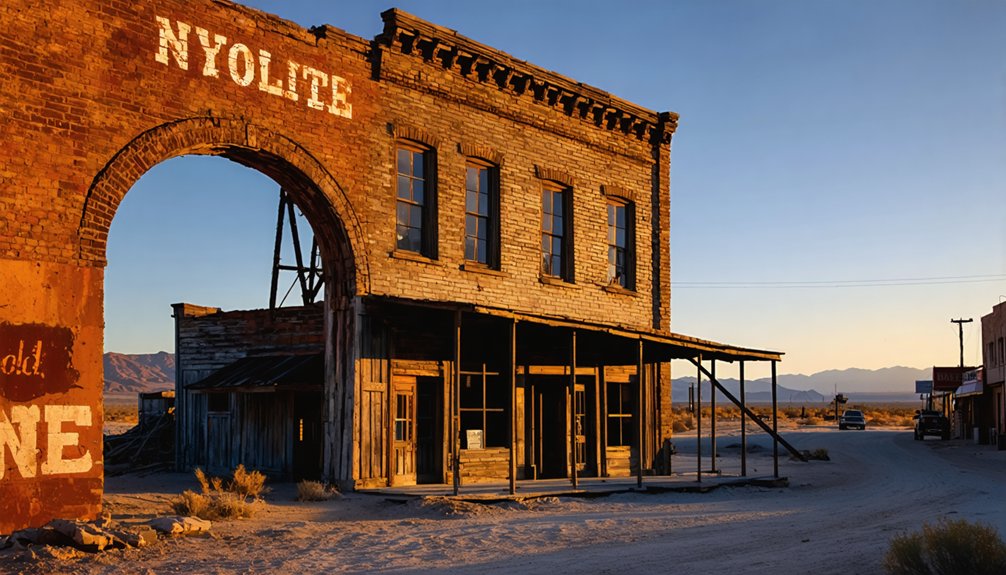You’ll find America’s best-preserved company town ruins in Bodie and Calico, California, and Chicago’s Pullman Historic District. Bodie offers an authentic gold rush town frozen in time with 110-170 original structures. Calico preserves the silver mining era with restored 1880s buildings. Pullman showcases over 1,000 brick rowhouses from George Pullman’s revolutionary 1880s planned community. These industrial time capsules reveal the complex relationship between American enterprise and the communities it created.
Key Takeaways
- Bodie, California preserves over 100 buildings in “arrested decay,” offering an authentic gold rush town experience.
- Calico Ghost Town showcases California’s silver mining heritage with restored structures from the 1880s boom period.
- Pullman Historic District maintains over 1,000 original brick rowhouses from George Pullman’s revolutionary planned community.
- These ghost towns display different industries: gold mining (Bodie), silver mining (Calico), and railroad car manufacturing (Pullman).
- All three sites have achieved landmark status and provide educational opportunities through preserved environments and artifacts.
Bodie, California: Gold Rush Heritage Frozen in Time
Between 1877 and 1882, you’d have found Bodie at its zenith—a bustling metropolis of 8,000–10,000 residents producing over $38 million in gold rush wealth.
The town boasted 65 saloons, hotels, and even its own Chinatown. The Chinese community contributed significantly through various trades such as laundry and logging.
After mining operations ceased in 1942, Bodie’s transformation into California’s official state gold rush ghost town began.
Today, you can explore approximately 110–170 buildings preserved in “arrested decay,” with original Bodie artifacts still displayed as they were abandoned—offering an authentic glimpse into America’s frontier past. The isolation of the town has helped preserve its structures and authentic interiors for modern visitors to experience.
Calico Ghost Town: Silver Mining Legacy in the Mojave Desert
Nestled in the rugged Calico Mountains of California’s Mojave Desert, Calico Ghost Town emerged in 1881 following one of the state’s largest silver strikes in history.
Within years, this silver mining hub swelled to 4,000 residents, supported by 500 mines that yielded approximately $20 million in silver and $9 million in borates.
Calico’s explosive growth transformed a barren mountainside into a thriving hub of 4,000 souls and unprecedented mineral wealth.
The town’s prosperity vanished when silver prices plummeted after the 1890 Silver Purchase Act.
By 1898, Calico’s post office closed as the population fled, leaving buildings to decay in desert conditions.
In the 1950s, Walter Knott purchased and restored the ghost town to its 1880s appearance.
Now a San Bernardino County park, Calico earned California Historical Landmark status in 1962 and was declared the Official State Silver Rush Ghost Town in 2005.
Beyond the main town area, visitors can discover remnants of the historic Chinatown District and old adobe structures.
Today, visitors can explore the town from 9 AM to 5 PM daily and experience its rich mining history through preserved structures and artifacts.
Pullman Historic District: The Revolutionary Model Company Town
Founded in 1880 by George M. Pullman, this 4,000-acre district south of Chicago represents America’s most ambitious planned industrial community.
Architect Solon Spencer Beman and landscape designer Nathan Barrett created a revolutionary urban vision with over 1,000 brick rowhouses and essential public buildings completed by 1884.
Pullman architecture featured unprecedented working-class amenities—indoor plumbing, gas lighting, and harmonious Queen Anne styling.
These technological innovations occurred alongside rigid company control that eventually sparked the watershed 1894 Pullman Strike when wage cuts weren’t matched by rent reductions.
Despite its labor history controversies, the district’s remarkable preservation earned it National Historic Landmark status in 1970.
Today, you’ll find over 1,000 original buildings maintained through community preservation efforts, offering an unparalleled window into America’s industrial past as a National Historical Park.
The town was designed to showcase the same high standards of luxury that made Pullman sleeping cars famous throughout America.
The iconic Administration Building and Clock Tower remain as notable landmarks in the collection of historically significant structures that document this unique experiment in industrial town planning.
Frequently Asked Questions
How Accessible Are These Sites for Visitors With Mobility Limitations?
You’ll face significant mobility challenges at most company town ruins. Site accessibility varies widely, with rugged terrain limiting wheelchair access while visitor centers typically offer more accommodations for your independent exploration.
Are There Accommodations for Overnight Stays Near These Historic Sites?
You’ll be amazed at the wealth of options! Most sites offer nearby historic lodging ranging from period-authentic inns to boutique hotels that contribute positively to local tourism impact and economic revitalization efforts.
What Preservation Techniques Protect These Ruins From Environmental Damage?
You’ll find restoration methods including protective shelters, drainage systems, vegetation management, and erosion controls implemented chronologically to minimize environmental impact while preserving these structures’ authentic character and ensuring your unrestricted access.
Can Visitors Collect Artifacts or Souvenirs From These Locations?
You can’t legally collect artifacts from these sites. Strict artifact collection policies and souvenir regulations prohibit removal to preserve historical integrity, with violations resulting in fines and potential criminal charges.
How Do American Company Towns Compare to International Industrial Settlements?
You’ll notice American company towns emphasized control through scrip currency and dense layouts, while international settlements often incorporated more green space, better wages, and cultural amenities, reflecting different approaches to industrial community development.
References
- https://www.letsroam.com/explorer/ancient-ruins-in-america/
- https://dot.ca.gov/-/media/dot-media/programs/environmental-analysis/documents/ser/townsites-a11y.pdf
- https://www.nps.gov/hafe/learn/historyculture/top-10-ruins.htm
- https://en.wikipedia.org/wiki/Wikipedia:WikiProject_Ghost_towns
- https://theweek.com/culture-life/travel/ghost-towns-usa-calico-bodie-burke-garnet-rhyolite
- https://www.geotab.com/ghost-towns/
- https://www.thedreamingmachine.com/american-canyon-ruins-the-past-and-the-future-of-concrete-history-and-graffiti-melina-piccolo/
- https://en.wikipedia.org/wiki/Ghost_town
- https://www.atlasobscura.com/things-to-do/united-states/company-town
- https://www.popularmechanics.com/culture/g34498423/company-towns-to-visit/



